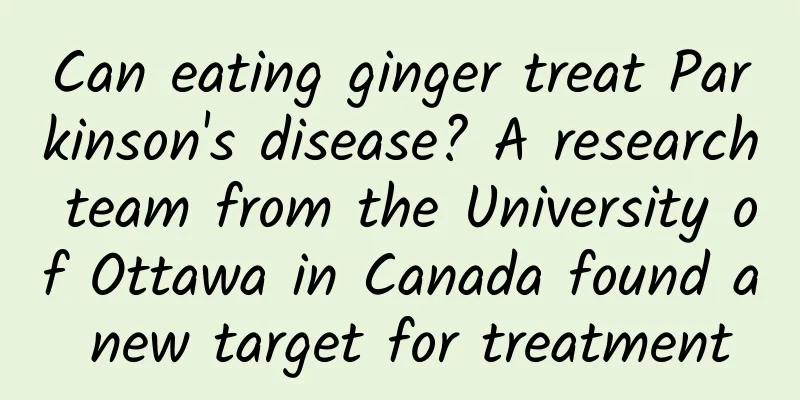Can eating ginger treat Parkinson's disease? A research team from the University of Ottawa in Canada found a new target for treatment

|
Parkinson's disease, also known as Parkinson's paralysis, is the second most common neurodegenerative disease after Alzheimer's disease. Patient symptoms can generally be divided into two categories: motor symptoms such as bradykinesia, staggering gait and resting tremor; and non-motor symptoms such as constipation, anosmia and sleep disorders. From a neuropathological perspective, Parkinson's disease patients show a large number of dopaminergic neuron deaths in the substantia nigra compact part of the brain, and a large number of Lewy bodies mainly formed by the aggregation of α-synuclein (α-Syn) appear in the surviving neurons, and the mutated α-Syn will spread between neurons like a prion. There is evidence that the mRNA content of SNCA (the gene encoding α-Syn protein) in neurons of Parkinson's disease patients increases, and overexpression of α-Syn in animal models can simulate some symptoms of Parkinson's disease, which indicates that there is a connection between the content of α-Syn and the pathological process of Parkinson's disease. However, the moderate cognitive impairment shown by Snca knockout mice reminds people that it is most beneficial to maintain an appropriate content of α-Syn in the brain. Recently, the research team of Maxime WC Rousseaux from the University of Ottawa in Canada published a research paper titled Genetic and pharmacological reduction of CDK14 mitigates synucleinopathy in the journal Cell Death & Disease [1]. The research team found that inhibiting cyclin-dependent kinase 14 (CDK14) by either gene editing or pharmacological means can alleviate the pathological progression of Parkinson's disease and prevent the spread of α-Syn among neurons, indicating that CDK14 may be a potential target for the treatment of Parkinson's disease. The research team injected pathological α-Syn preformed fibrils (mouse α-Syn PFF) into the brains of CDK14 knockout (CDK14+/+) and semi-knockout (CDK14+/-) mice to induce Parkinson's disease symptoms. They found that CDK14 knockout could effectively rescue the loss of grip strength in mice caused by α-Syn PFF and reduce the aggregation of α-Syn in the brain. Specifically, in different brain regions, CDK14 knockout had little effect on the aggregation of α-Syn at the injection site, but could effectively reduce the aggregation of α-Syn in brain regions far away from the injection area (Figure 1 AD). Unfortunately, CDK14 knockout did not improve dopaminergic neuron death (Figure 1 E, TH: tyrosine hydroxylase, an enzyme that catalyzes the conversion of tyrosine to dopamine, is a key enzyme in the dopamine synthesis pathway). At the same time, CDK14 knockout did not change the overall endogenous α-Syn content in the mouse brain. In addition, the research team was able to inhibit the aggregation of α-Syn by knocking out CDK14 in human neurons. Using primary neurons in vitro, the research team found that CDK14 knockout actually slowed down the diffusion of α-Syn between cells. In addition to gene editing, the research team also used the CDK14 inhibitor , FMF-04-159-2, to pharmacologically inhibit CDK14, and found that CDK14 inhibitors can effectively reduce the production of insoluble proteins of α-Syn aggregation in human neurons and PFF-induced rat primary neurons, and this phenomenon has also been verified in the Parkinson's disease mouse model. In summary, the research team found that CDK14 may be a potential target for the treatment of Parkinson's disease by targeting the spread of α-Syn. However, it is worth noting that the research team has not yet explored the specific mechanism by which CDK14 regulates α-Syn. Compared with the free α-Syn protein outside the cell, neurons are more inclined to engulf α-Syn in exosomes[2]. CDK14 may be involved in the release of α-Syn exosomes, but this still needs to be further explored by future researchers. Figure 1 CDK14 knockout improves grip strength and α-Syn pathology in Parkinson's disease mouse model. The black asterisks represent the injection sites. CL: contralateral to the injection site. IL: ipsilateral to the injection site. To date, there is still a lack of effective therapeutic drugs for Parkinson's disease. The limited means are mainly limited to the movement disorder symptoms of Parkinson's disease, such as the use of dopaminergic drugs (dopamine precursors and dopamine agonists, or MAO-B, COMT and decarboxylase and other enzyme inhibitors involved in dopamine metabolism) to alleviate the occurrence of movement disorders. For the non-motor symptoms of Parkinson's disease, antidepressants, sedatives or cholinesterase inhibitors (which have an excitatory effect) are more often selected according to the symptoms [3]. In recent years, with the in-depth study of the pathological mechanism of Parkinson's disease, some new therapeutic drugs or methods have also been proposed. Studies on reducing the generation or aggregation of α-Syn have found that curcumin, a natural product extracted from ginger plants, has good neuroprotective effects and can significantly inhibit the aggregation of α-Syn[4]. Small molecule inhibitors of α-Syn, NPT200-11 and NPT088, can also significantly reduce the aggregation and neuroinflammation of α-Syn in the brain and improve movement disorders in animal models[3]. Among them, NPT200-11 can be taken orally and penetrate the blood-brain barrier into the brain. Currently, NPT200-11 has completed Phase I clinical trials and has shown good safety and tolerability at multiple doses (NCT02606682). NPT088 can target the aggregation of α-Syn, Aβ and Tau and reduce the deposition of proteinase K-resistant proteins. In addition to small molecule inhibitors, targeted degradation of SCNA mRNA by antisense oligonucleotides (ASOs) can also effectively reduce the expression of α-Syn. For example, the AmNA-ASO designed by Uehara et al. can effectively inhibit the production of α-Syn and improve the pathological progression of Parkinson's disease animal models [5]. In addition, intracellular antibodies (Intrabodies) that target α-Syn monomers and inhibit their aggregation may also be an effective means. For example, the VH14*PEST nanobody designed by Jeffrey H Kordower et al. (Nanobodies are single-domain antibody fragments that can specifically bind to antibodies, which are convenient for genetic engineering and delivery) can effectively reduce the aggregation of α-Syn and the occurrence of neuroinflammation, and improve motor dysfunction in animal models [6]. However, unlike traditional drug delivery methods, the difficulty of intracellular antibody delivery is that the antibodies need to be delivered into cells through suitable viral vectors, and how to maintain the content of intracellular antibodies for a long time is also a challenge that needs to be solved in future clinical practice. Finally, the use of structure-dependent binding oligomer regulators can broadly target the aggregation of prions or α-Syn. For example, Anle138b screened by Jens Wagner et al. has good neuroprotective effects both in vivo and in vitro, can effectively inhibit the aggregation of α-Syn, and exhibits good oral effects and cross-blood-brain barrier properties [7]. Yong Tae Kwon et al., based on autophagy-targeting chimera technology (AUTOTAC), used Anle138b as a ligand to synthesize a compound targeting α-Syn aggregates, ATC161, which effectively guided α-Syn aggregates to lysosomes for degradation, and no obvious off-target effects were observed. In animal models, ATC161 also showed good oral effects and improved movement disorders [8]. Of course, among the drugs for the treatment of Parkinson's disease, in addition to those targeting α-Syn, there are also β2AR agonists, LAG3 receptor antagonists, and drugs that enhance autophagy signals or provide neuroprotection, which are also under development [3]. I believe that in the future, people will be able to overcome the difficulty of Parkinson's disease. References: [1] Parmasad JA, Ricke KM, Nguyen B, et al. Genetic and pharmacological reduction of CDK14 mitigates synucleinopathy. Cell Death Dis. 2024;15(4):246. Published 2024 Apr 4. doi:10.1038/s41419-024-06534-8 [2] Danzer KM, Kranich LR, Ruf WP, et al. Exosomal cell-to-cell transmission of alpha synuclein oligomers. Mol Neurodegener. 2012;7:42. Published 2012 Aug 24. doi:10.1186/1750-1326-7-42 [3] Gouda NA, Elkamhawy A, Cho J. Emerging Therapeutic Strategies for Parkinson's Disease and Future Prospects: A 2021 Update. Biomedicines. 2022;10(2):371. Published 2022 Feb 3. doi:10.3390/biomedicines10020371 [4] Sharma N, Nehru B. Curcumin affords neuroprotection and inhibits α-synuclein aggregation in lipopolysaccharide-induced Parkinson's disease model. Inflammopharmacology. 2018;26(2):349-360. doi:10.1007/s10787-017-0402-8 [5] Uehara T, Choong CJ, Nakamori M, et al. Amido-bridged nucleic acid (AmNA)-modified antisense oligonucleotides targeting α-synuclein as a novel therapy for Parkinson's disease. Sci Rep. 2019;9(1):7567. Published 2019 May 21. doi:10.1038/s41598-019-43772-9 [6] Chatterjee D, Bhatt M, Butler D, et al. Proteasome-targeted nanobodies alleviate pathology and functional decline in an α-synuclein-based Parkinson's disease model. NPJ Parkinsons Dis. 2018;4:25. Published 2018 Aug 22. doi:10.1038/s41531-018-0062-4 [7] Wagner J, Ryazanov S, Leonov A, et al. Anle138b: a novel oligomer modulator for disease-modifying therapy of neurodegenerative diseases such as prion and Parkinson's disease. Acta Neuropathol. 2013;125(6):795-813. doi:10.1007/s00401-013-1114-9 [8] Lee J, Yoon D, Sung KW, et al. Targeted degradation of SNCA/α-synuclein aggregates in neurodegeneration using the AUTOTAC chemical platform. Autophagy. 2024;20(2):463-465. doi:10.1080/15548627.2023.2274711 |
<<: National Hair Care Day丨If you pull out one grey hair, 10 will grow back? Should you pull it out?
>>: How to avoid bruising and hematoma after venous blood sampling?
Recommend
Vulvar dryness and itching
The most common diseases that occur in women are ...
Light fasting weight loss method: Master the magic of scientifically balanced weight loss
In the pursuit of health and ideal body shape, pe...
How to treat chronic inflammation of the fallopian tube?
For many people who want to be mothers, especiall...
What should I do if I have menstrual abdominal pain?
I believe every woman is familiar with menstruati...
How long in advance can a cesarean section be performed?
Many women are afraid of the pain of natural chil...
Low progesterone, gestational sac cannot be seen on ultrasound
During the examination, if the progesterone level...
What are the symptoms of follicle discharge?
Female pregnancy is a complicated process. In ord...
How long do I need to rest after Lip Knife surgery?
In daily life, gynecological diseases are a major...
What tests are needed for pregnancy preparation at an older age?
As China's population is gradually aging, the...
United Nations: Research report on China's social and e-commerce platforms and China's digital payment ecosystem
The Better_Than_Cash_Alliance under the United Na...
What is the soy sauce in Cantonese cuisine? What are the famous soups in Cantonese cuisine?
As we all know, soy sauce, a delicacy on the Cant...
Is the process of medical abortion painful?
The process of medical abortion is not painful, b...
5.31 World No Tobacco Day
5.31 World No Tobacco Day World No Tobacco Day &q...









